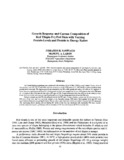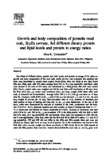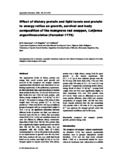Voluntary feed intake and energy partitioning in tilapia, (Oreochromis niloticus) fed diets with different protein/energy levels
Share
Abstract
In order to investigate the effect of different protein/energy levels of diets (two commercial and one laboratory) on voluntary feed intake and energy partitioning in tilapia (O. niloticus), 15 fishes with an initial body mass of 33 g were reared individually in respirometric chambers for 42 days and offered 3 diets ad libitum. The protein contents of the diets were 36.1, 33.8 and 36.8% (dry matter base); the energy content 18.9, 18.4 and 19.2 kJ GE/g and 11.7, 10.5 and 15.4 kJ ME/g. The initial body composition and energy content was estimated from a control group. Feed consumption was recorded for each individual fish. Body mass development was monitored weekly. At the end of the experiment, the fishes were sacrificed and their chemical composition (protein as N.6.25, lipid, ash) and gross energy content were determined. To establish energy budgets, ingestion (I) was calculated from feed intake, retention (P) from accretion in the carcass, heat production (R) from oxygen consumption (indirect calorimetry) and apparently non-utilized energy (faecal and non-faecal losses, U) by difference from energy ingestion.
In the beginning, food consumption amounted to ~5% body mass equivalent (BME) per day for all groups and gradually decreased to 2.5, 2.8 and 1.6% BME by the end of the experiment. While the food consumption was significantly different between the treatments, there were no significant differences in the body mass development. Average final body mass was 98.6, 93.8 and 103.7 g. Energy retention was 29.7, 29.2 and 44.4% of GE ingested; heat dissipation 32.1, 27.9 and 36.0%; faecal and non-faecal losses 38.2, 43.2 and 19.6%. For all energy budget parameters, values for the laboratory diet were significantly different from those of commercial feeds 1 and 2. Calculation of metabolizable energy from ingested feed revealed no significant differences in the energy uptake, suggesting that the voluntary feed uptake was controlled by the demand for metabolizable energy. The fishes were able to completely compensate for the lower ME content of the commercial feeds by increasing voluntary feed intake.
Paksa
Mga koleksyon
Related items
Showing items related by title, author, creator and subject.
-
Growth response and carcass composition of red tilapia fry fed diets with varying protein levels and protein to energy ratios
Santiago, Corazon B.; Laron, Manuel A. (Asian Fisheries Society, 1991)An 8-week feeding experiment was conducted with red tilapia (Oreochromis ) fry of 0.160 plus or minus 0.035 g initial weight. Twelve diets of 4 protein levels (25, 30, 35 and 40%) and 3 protein to energy (P/E) ratios (111, ... -
Growth and body composition of juvenile mud crab, Scylla serrata, fed different dietary protein and lipid levels and protein to energy ratios.
Catacutan, Mae R. (Elsevier, 2002)The effect of different dietary protein and lipid levels, and protein to energy (P/E) ratios on growth and body composition of the mud crab, Scylla serrata, was evaluated. Six practical test diets were formulated ... -
Effect of dietary protein and lipid levels and protein to energy ratios on growth, survival and body composition of the mangrove red snapper, Lutjanus argentimaculatus (Forsskal 1775)
Catacutan, M. R.; Pagador, G. E.; Teshima, S. (Wiley-Blackwell, 2001)The approximate levels of dietary protein and energy that would sustain good growth and survival of the mangrove red snapper Lutjanus argentimaculatus (Forsskal) were determined in two feeding experiments. In the ...




